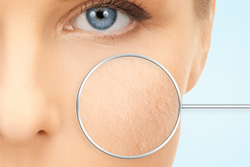THE BASICS OF UNDERSTANDING YOUR SKIN’S STRUCTURE AND FUNCTION
You might know that the skin is the largest organ of the human body, and you might also know that skin is made up of several layers. But for something that makes up about 16% of our body weight, there is still so much about the skin that many of us simply do not understand. Our skin is a dynamic organ that covers about 19 square feet which is a lot of skin to care for. Learning about your skin’s structure and function can help you to address its needs so you can take better care of this vital organ.
Your Skin’s Structure
Epidermis:
This is your skin’s top layer – the one we can see. It provides an essential barrier to the environment and contains a protective coating called the acid mantle. This layer is constantly being renewed as cells move up from the epidermis’ bottom layer to the skin’s surface where they are eventually shed. Since natural regeneration of your skin slows by about 10% per decade, it is important to seek skin care that contains regular, gentle exfoliation to help the cell renewal process.
Dermis:
The dermis is the middle layer of the skin which contains structural elements like collagen and elastin that give your skin elasticity, spring, and strength. The dermis also contains oil-producing glands (sebaceous glands), sweat glands, hair follicles, and blood vessels. The sebaceous glands produce your skin’s natural oil, sebum, which makes skin supple and helps keep pores free of dirt and bacteria. Thinning skin and wrinkles are mainly due to changes in the dermis like the loss collagen and the weakening of elastin. Skin care that stimulates collagen production and protects elastin will help your skin stay strong and plump.
Hypodermis:
The hypodermis or subcutaneous tissue, both meaning under the skin, refer to your skin’s bottom layer. This layer of the skinis made up of fat, connective tissues, large blood vessels, and nerves. The hypodermis provides underlying support, structure, and nutrients to the upper two layers of the skin. This layer is much less affected by skin care and much more by how younourish your body and care for your overall health.

The hypodermis or subcutaneous tissue, both meaning under the skin, refer to your skin’s bottom laver. This laver of the skin is made up of fat, connective tissues, large blood vessels, and nerves. The hypodermis provides underlying support, structure, and nutrients to the upper two layers of the skin. This layer is much less affected by skin care and much more by how you nourish your body and care for your overall heath.
Your Skin’s Function
Your skin’s function is mainly to serve as the body’s first line of defense. It provides protection for your body from the environment, bacteria, and water loss. It also insulates your body, helps regulate temperature, and synthesizes vitamin D. Dry skin or irritated skin severely weakens its ability to protect your body, making it important to adopt nourishing skin care habits.
Your Sense of Touch
Your skin also provides another important function by communicating through its sense of touch. Skin’s sensory perception ability allows you to express love, feel loved, and to help interpret your environment. Sense of touch is incredibly important to avoid pressure and extreme cold or heat, allowing us to quickly react to any of these impending dangers.
Your Skin’s Appearance
The appearance of your skin helps define who you are. Your facial skin works in conjunction with muscles to communicate different facial expressions and moods to those around you. Whether young or old, ill or healthy, tired or energetic, the condition and appearance of your skin conveys a lot to the world around you. By knowing your skin’s needs, you can improve its condition and appearance with proper nourishing skin care.







